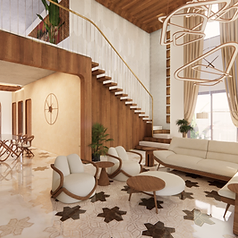Contact : +91 9632587562
An Interior Architect is a professional who combines the technical and creative aspects of architecture with the artistic elements of interior design to create functional, aesthetically pleasing, and safe interior environments. Their role goes beyond choosing decor or arranging furniture; they are responsible for shaping the spatial and functional qualities of a building's interior, ensuring it aligns with the needs of its occupants while meeting structural, safety, and regulatory standards.
Key Responsibilities of an Interior Architect
-
Space Planning: One of the primary responsibilities of an interior architect is to optimize space. They analyze the layout of an area, considering factors such as functionality, flow of movement, ergonomics, and the relationship between various spaces. This planning ensures that the interior space serves its intended purpose effectively, whether it's a residential, commercial, or public setting.
-
Design Development: Interior architects focus on creating detailed designs that balance aesthetics with functionality. They consider factors like natural light, ventilation, acoustics, and human interaction with the space. These designs are usually in the form of 2D plans and 3D visualizations, helping clients and construction teams understand the intended outcome.
-
Material Selection: The choice of materials is critical in the field of interior architecture. An interior architect selects materials not only for their visual appeal but also for their durability, sustainability, and safety. They must consider fire resistance, acoustic properties, and environmental impact, particularly in commercial spaces where regulatory standards are stringent.
-
Collaboration with Other Professionals: An interior architect often works in close coordination with architects, engineers, contractors, and interior designers. Their role may include overseeing the implementation of design plans to ensure that the interior spaces are constructed according to the specifications. Effective communication is key as they may need to provide guidance on structural changes, material installation, or adjustments to meet practical constraints.
-
Sustainability and Innovation: Modern interior architects are increasingly adopting sustainable practices. This includes using eco-friendly materials, maximizing energy efficiency, and designing spaces that minimize environmental impact. For instance, they may incorporate natural lighting solutions, optimize airflow to reduce the need for air conditioning, or select materials with a lower carbon footprint.
-
Building Codes and Safety Standards: One of the critical aspects of interior architecture is ensuring compliance with local building codes, safety regulations, and accessibility requirements. Interior architects are well-versed in these regulations and must ensure that their designs are structurally sound and adhere to fire safety, electrical standards, and accessibility norms.
The Difference Between an Interior Architect and an Interior Designer
While the roles of an interior architect and an interior designer may seem similar, they differ in scope and focus. An interior designer typically focuses on the aesthetic elements of a space, such as color schemes, furniture, and decorative pieces. In contrast, an interior architect works on the technical aspects of interior spaces, including structural changes, spatial layout, and the integration of mechanical, electrical, and plumbing systems. Essentially, interior architects are involved in the architectural design and construction process, while interior designers focus on the final touches that make a space visually appealing.
Skills Required for an Interior Architect
-
Creative and Technical Skills: Interior architects need to blend creativity with technical knowledge. They must have a deep understanding of construction techniques, materials, and architectural principles while also possessing the artistic vision to create visually compelling spaces.
-
Problem-Solving: Interior architects often face challenges in optimizing space, dealing with unexpected structural issues, or meeting clients' specific needs. Strong problem-solving skills are essential for finding innovative solutions.
-
Attention to Detail: Precision is crucial when working on complex design plans. Small errors in measurements or materials can lead to costly mistakes, so attention to detail is vital.
-
Communication Skills: Working with clients, contractors, and other professionals requires clear and effective communication. An interior architect needs to convey their ideas clearly and ensure that all stakeholders are on the same page.
Conclusion
Interior architecture is a dynamic and evolving field that requires a balance of technical expertise, creativity, and practical problem-solving skills. Interior architects play a vital role in transforming spaces, making them both functional and visually appealing, while ensuring they meet safety and regulatory standards. As design trends continue to evolve and sustainability becomes increasingly important, the role of interior architects will remain integral to shaping the spaces in which people live, work, and interact.
.jpg)
